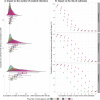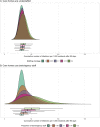Hybrid simulation modelling of networks of heterogeneous care homes and the inter-facility spread of Covid-19 by sharing staff
- PMID: 35020731
- PMCID: PMC8789158
- DOI: 10.1371/journal.pcbi.1009780
Hybrid simulation modelling of networks of heterogeneous care homes and the inter-facility spread of Covid-19 by sharing staff
Abstract
Although system dynamics [SD] and agent-based modelling [ABM] have individually served as effective tools to understand the Covid-19 dynamics, combining these methods in a hybrid simulation model can help address Covid-19 questions and study systems and settings that are difficult to study with a single approach. To examine the spread and outbreak of Covid-19 across multiple care homes via bank/agency staff and evaluate the effectiveness of interventions targeting this group, we develop an integrated hybrid simulation model combining the advantages of SD and ABM. We also demonstrate how we use several approaches adapted from both SD and ABM practices to build confidence in this model in response to the lack of systematic approaches to validate hybrid models. Our modelling results show that the risk of infection for residents in care homes using bank/agency staff was significantly higher than those not using bank/agency staff (Relative risk [RR] 2.65, 95% CI 2.57-2.72). Bank/agency staff working across several care homes had a higher risk of infection compared with permanent staff working in a single care home (RR 1.55, 95%CI 1.52-1.58). The RR of infection for residents is negatively correlated to bank/agency staff's adherence to weekly PCR testing. Within a network of heterogeneous care homes, using bank/agency staff had the most impact on care homes with lower intra-facility transmission risks, higher staff-to-resident ratio, and smaller size. Forming bubbles of care homes had no or limited impact on the spread of Covid-19. This modelling study has implications for policy makers considering developing effective interventions targeting staff working across care homes during the ongoing and future pandemics.
Conflict of interest statement
The authors have declared that no competing interests exist.
Figures





Similar articles
-
COVID-19 in Scottish care homes: A metapopulation model of spread among residents and staff.Epidemics. 2024 Sep;48:100781. doi: 10.1016/j.epidem.2024.100781. Epub 2024 Jul 5. Epidemics. 2024. PMID: 38991457
-
Estimation of Transmission of COVID-19 in Simulated Nursing Homes With Frequent Testing and Immunity-Based Staffing.JAMA Netw Open. 2021 May 3;4(5):e2110071. doi: 10.1001/jamanetworkopen.2021.10071. JAMA Netw Open. 2021. PMID: 33988707 Free PMC article.
-
The palliative care experience in Irish nursing homes during the COVID-19 pandemic: a survey of residents, family, and staff.BMC Palliat Care. 2024 May 22;23(1):126. doi: 10.1186/s12904-024-01458-8. BMC Palliat Care. 2024. PMID: 38773544 Free PMC article.
-
Relationship between staff and quality of care in care homes: StaRQ mixed methods study.Health Soc Care Deliv Res. 2024 Apr;12(8):1-139. doi: 10.3310/GWTT8143. Health Soc Care Deliv Res. 2024. PMID: 38634535
-
COVID-19 in Nursing Homes: Calming the Perfect Storm.J Am Geriatr Soc. 2020 Oct;68(10):2153-2162. doi: 10.1111/jgs.16784. Epub 2020 Sep 2. J Am Geriatr Soc. 2020. PMID: 32735036 Review.
Cited by
-
A model-based assessment of social isolation practices for COVID-19 outbreak response in residential care facilities.BMC Infect Dis. 2024 Aug 29;24(1):880. doi: 10.1186/s12879-024-09788-x. BMC Infect Dis. 2024. PMID: 39210276 Free PMC article.
-
Application of a composite, multi-scale COVID-19 mitigation framework: US border use-case.Health Syst (Basingstoke). 2023 Dec 21;14(1):12-30. doi: 10.1080/20476965.2023.2287506. eCollection 2025. Health Syst (Basingstoke). 2023. PMID: 39989915 Free PMC article.
-
Investigation of airborne spread of COVID-19 using a hybrid agent-based model: a case study of the UK.R Soc Open Sci. 2023 Jul 26;10(7):230377. doi: 10.1098/rsos.230377. eCollection 2023 Jul. R Soc Open Sci. 2023. PMID: 37501658 Free PMC article.
-
Predictions from standard epidemiological models of consequences of segregating and isolating vulnerable people into care facilities.PLoS One. 2023 Oct 30;18(10):e0293556. doi: 10.1371/journal.pone.0293556. eCollection 2023. PLoS One. 2023. PMID: 37903148 Free PMC article.
-
An agent-based model to assess the impact of shared staff and occupancy rate on infectious disease burden in nursing homes.BMC Infect Dis. 2025 Apr 30;25(1):635. doi: 10.1186/s12879-025-10786-w. BMC Infect Dis. 2025. PMID: 40301788 Free PMC article.
References
-
- Ladhani SN, Chow JY, Janarthanan R, Fok J, Crawley-Boevey E, Vusirikala A, et al.. Increased risk of SARS-CoV-2 infection in staff working across different care homes: enhanced CoVID-19 outbreak investigations in London care Homes. Journal of Infection. 2020. doi: 10.1016/j.jinf.2020.07.027 - DOI - PMC - PubMed
-
- Shallcross L, Burke D, Abbott O, Donaldson A, Hallatt G, Hayward A, et al.. Factors associated with SARS-CoV-2 infection and outbreaks in long-term care facilities in England: a national cross-sectional survey. The Lancet Healthy Longevity. 2021;2(3):e129–e42. doi: 10.1016/S2666-7568(20)30065-9 - DOI - PMC - PubMed
-
- GOV UK Department of Health and Social Care. Proposal to regulate to stop movement of staff between care settings 2020. [Available from: https://www.gov.uk/government/consultations/stopping-movement-of-staff-b....
-
- Scottish Social Services Council. Scottish Social Service Sector: Report on 2019 Workforce Data: An Official Statistics Publication for Scotland 2020. [Available from: https://data.sssc.uk.com/data-publications/22-workforce-data-report.
Publication types
MeSH terms
LinkOut - more resources
Full Text Sources
Medical

